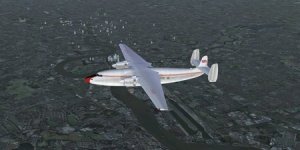The Ambassador had its origin in 1943 as a requirement identified by the Brabazon Committee for a twin-engined, short to medium-haul replacement for the Douglas DC-3. Airspeed Ltd. was asked to prepare an unpressurised design in the 14.5 ton gross weight class, using two Bristol Hercules radial engines. In 1943 the company duly set up a dispersed design office in Fairmile Manor at Cobham in Surrey. By the time the British Ministry of Aircraft Production ordered two prototypes from Airspeed, immediately after the end of the Second World War, the design had grown substantially. The Ambassador would be pressurized, have more powerful Bristol Centaurus radials, and have a maximum gross weight of almost 24 tons. The revised design offered seating for 47 passengers and, having a nose wheel undercarriage, looked more modern than the DC-3s, Curtiss Commandos, Avro Lancasters and Vickers Vikings that were common on Europe's shorter airline routes. With three low fins and long pointed nose it shared something of the character of the larger transcontinental Lockheed Constellation. Great efforts were made to reduce drag, to improve performance and cruising efficiency.
The engine nacelles were first designed with inwardly opening louvres for exhaust gases and cooling air, rather than the usual outwardly opening "gills." However, these proved inadequate to cool the engine, and the gills were reinstated.
The engine nacelles were first designed with inwardly opening louvres for exhaust gases and cooling air, rather than the usual outwardly opening "gills." However, these proved inadequate to cool the engine, and the gills were reinstated.

